Mountain Katydid - Acripeza reticulata
Family TETTIGONIIDAE
This page contains pictures and information about the Mountain Katydids that we found in the Brisbane area, Queensland, Australia. They are also known Mountain Grasshopper.

- Male, head to wing-tip 60mm
- Mountain Katydid is one of the Australian Insect Icon because of its remarkable colours. In normal, the insect is well camouflaged as dry leaf in dark brown colour. The katydids don't show their colours unless they are disturbed. Then they raise the wing-covers and exposes the bright red, blue and black striped abdomen.
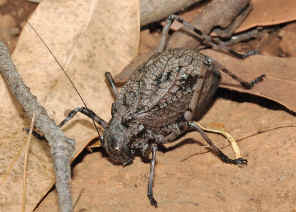
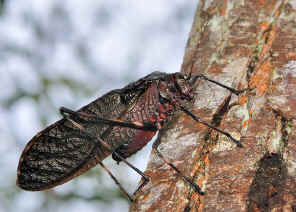
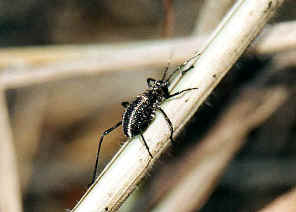
- Female, body length 30mm Male Nymph
- Females are incapable of flight, having only small shell-like forewings They do not have the 2nd pair membrane functional wings. Male is fully winged, can fly and look quite different. We found the females a few times but found the male once. Nymph is dull brown to black in colour, with orange bands and orange collar, but no blue dotted lines. Larger nymph has wing buds.
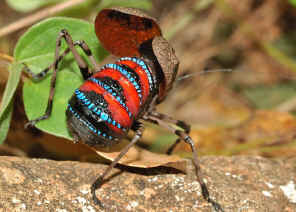
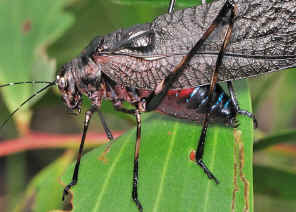
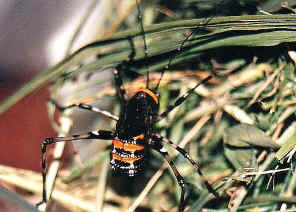
- As a general rule, they display their colours only if touched. They raise their wings to reveal bright coloured bands on the abdomen which presumably serve an aposematic function.
- Check this page to hear their calling. Males sing in late afternoon and continues until after dark. Females lay eggs in topsoil.
- From different reference information which indicated that the Mountain Katydids may be abundant in a local area for a short period of time. Then their number dropped very quickly to almost completely disappeared. This could be due to the supply of the food plants. They are definitely not restricted only to mountains. We found them in different location, include low bushland and next to creek. All areas we found them were somewhat the wet eucalypt forest.
- Edith Coleman commented in her 1938 paper that "They are numerous only where the ragwort abounds." The main feeding times of the Acripeza are twice daily, in the morning and evening. They like sun-basking and quite active during this two periods. They rest under shelter for most of the other time.
- Within the ten years we found the Mountain Katydid only a few times. The first time was the nymph on a log. Then an adult female was found on leaf and other two females on tree trunk. All of them jumped onto the ground after we took a few photos. The latest we found an adult male on 2010. Every time we felted like seeing an old friend when we saw a Mountain Katydid. Followings are the records that we met our old friend since we first knew the Mountain Katydid on 2002.
Nymph, Yugarapul Park, Sep 2002
- We initially thought Mountain Katydid live in high altitude habitat. Anyway, we first found this Mountain Katydid nymph near Yugarapul Park in Sunny Bank, Brisbane. Where is a low wet dense Eucalypt forest next to the Bulimba Creek. It was September 2002. The nymph was resting on a dry grass. We took it home to see how it grow.

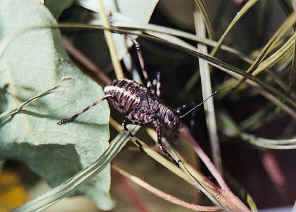
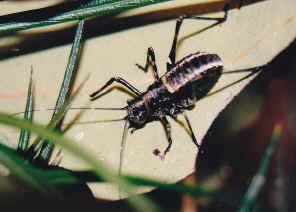
- Male nymph, body length 25mm
- The Mountain katydid nymph was black in colour with two white strips on its back. It was slow moving. When disturbed, it bended its abdomen and show the bright orange colour.
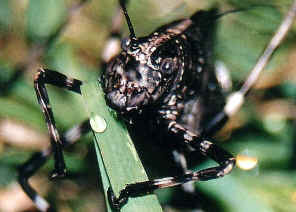

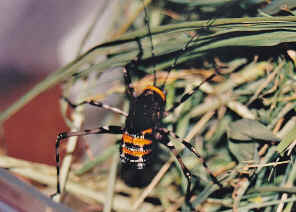
- Two months later
- It moulted once within two months. Notice its two pair of wing-buds. From the reference information, male Mountain Katydid nymph has two pair of wing-buds while female only has one pair. So it's a boy!!
- We found that it feed on grass and like to eat the grass seeds. In the close up picture, we can cleanly see its mouth-parts and its hearing organs on its front legs. It dead two months later. We did not know why it dead.
Female, Yugarapul Park, Dec 2005
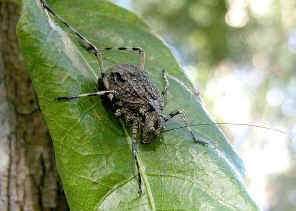
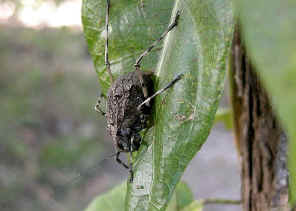
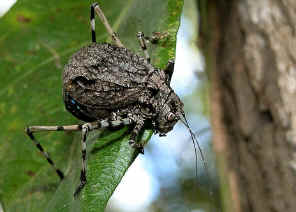
- Body length 30mm
- On Dec 2005, we found another Mountain Katydid in Yugarapul Park, about the same area where we found the nymph three years ago. It was an adult female. It was resting on a Monkey Rope (Parsonsia straminea) leaf about half a meter above ground in a hot summer afternoon. We looked around and did not see other Mountain Katydid.
-
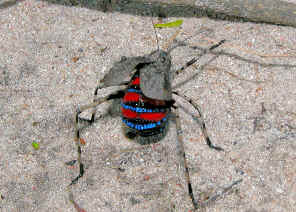
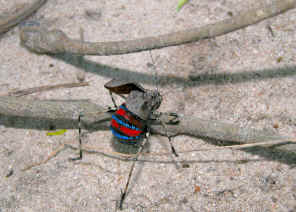
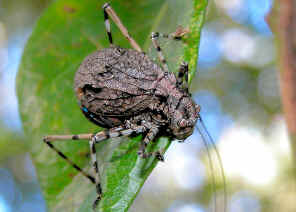
- Unlike most other katydids, the katydid was slow moving and not able to hop. When disturbed, it drop onto the ground and displayed it colour-banded abdomen. Then it slowly walked away. We discussed its primary and secondary defence below.
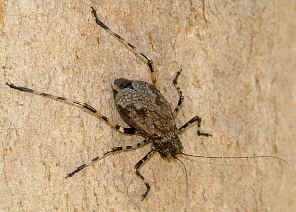
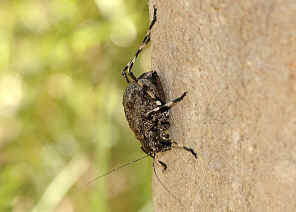
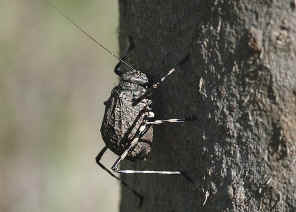
- Body length 40mm
- On Feb 2007, in Karawatha Forest Wild-May Trail just next to the Lagoon, we found another female Mountain Katydid. It was quite unexpected because where was an open Eucalypt Forest next to the wetland, very different from the dense forest in Yugarapul Park. The only thing in common was both locations were very close to a creek with small pond.
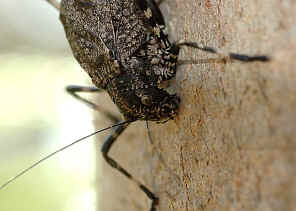
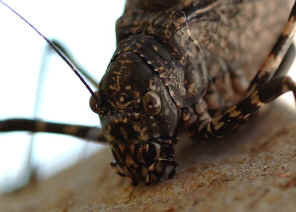
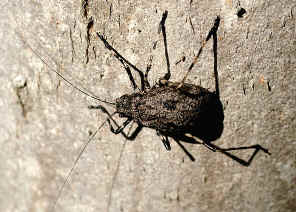
- The katydid was resting on a large gum tree trunk about 1 meter above ground. After we took some photos, it jumped onto the ground and slowly walk away.
- This individual we found is the larger than the one above. Its body length was 40mm.
Female, Karawatha Forest Wild-May Trail, Feb 2007
Females and nymphs, Mt Tamborine, Beacon, Apr 2008
- We received emails from Ian Menkins on Apr 2008. He advised that: " The mountain katydid was extremely common around Mt Tamborine a couple months ago. So common in fact that residents reported being unable to walk around on their lawns without stepping on them. I visited on the weekend and found about 40. There were both adult males and females, and lots of little nymphs. Their numbers have dropped off, as it seems they've almost completely eaten out the Ragwort Senecio spp. that is prevalent on the mountain. "
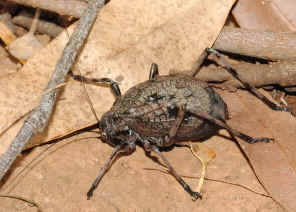

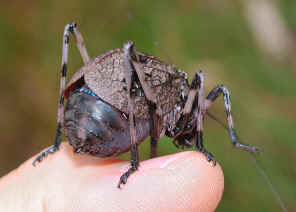
- We got the directions from Ian and went to Mt Tamborine to try our luck. It was a cloudy day with some rains. We found a female. It was resting on a small rock, disturbed by the falling soils that we made when we walked down the slope.
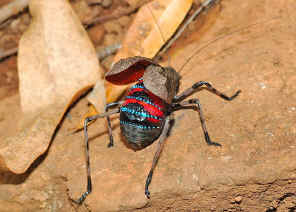


- We quickly took some photos, let it walk on my hand and then let it go. The female katydid was quite heavy, should be full of eggs.
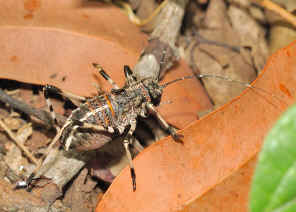

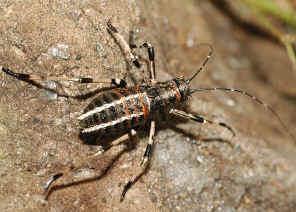
- Female nymph
- Then about a few meters away we saw an nymph hiding in dense grasses. We took a few photos too. This nymph had only one pair of wing-bud so we believed it was a girl.
- Then we spent another two hours in the area, hoping to find some more and even a male, but no more luck.
Male, Ford Road Conservation Area, Mar 2010
- We found the female Mountain Katydids a few times but never saw a male. Finally we found one male on Mar 2010 in Ford Road Conservation Area. Where was a wet open Eucalypt forest on a gentle hill slope
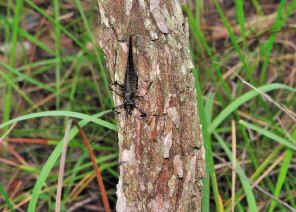
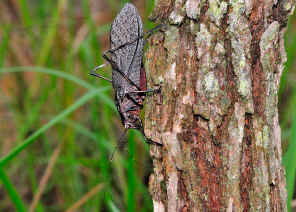
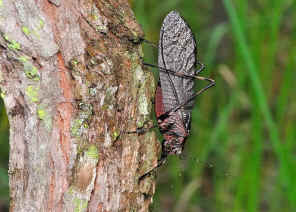
- The male Mountain Katydids was found resting on a medium size tree trunk about a meter above ground. The katydid was well camouflaged and hardly be noticed. We noticed it only because it was weaving its long antenna.
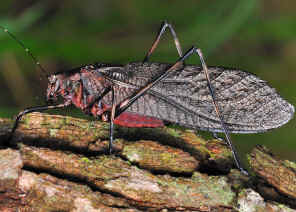
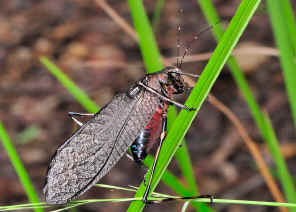
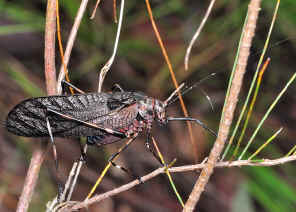
- The male Mountain Katydid looked very different to the female. The male's body and wings were the typical katydid shape in the subfamily Phaneropterinae, with thin narrow body and gum leaf shape wings. Except it is resemble a dry dark brown leaf instead of a green fresh leaf.
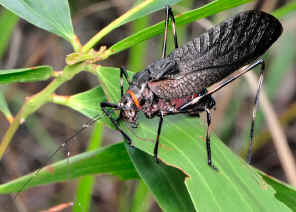
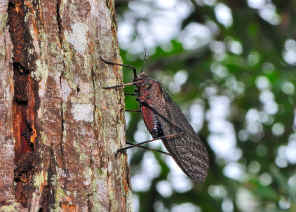

- When first looked at the katydid, we did not recognize it was a Mountain Katydid. In our mind Mountain Katydid was a large fat round insect. We thought we found a new black katydid species.
- We realized it was a male Mountain Katydid when it showed its orange neck ring and its blue-red banded abdomen.
- The male Mountain Katydid was slow moving, when touched, it flied to a few meters away and landed on medium size tree trunk or on glasses. It was not a good flier, just like other species in the Bush Katydids subfamily.
Female nymph, Daisy Hills, Nov 2010
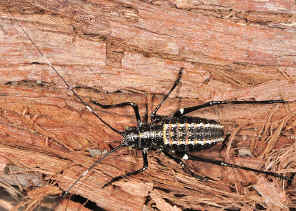
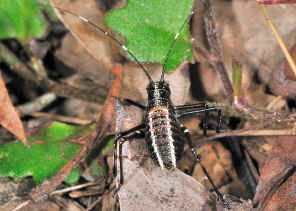
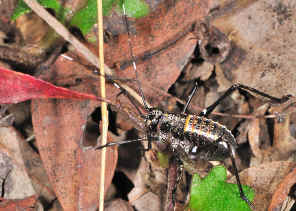
- This confirmed two that Mountain Katydid can be found on Daisy Hills.
- To our surprise, on Daisy Hills we found a male Mountain Katydid get caught in a Golden Orb-Weaver spider web. It was about two meters above ground.
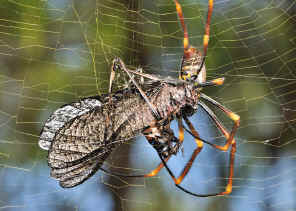
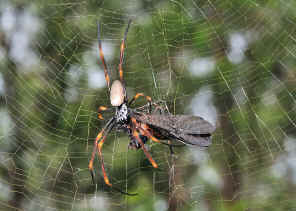
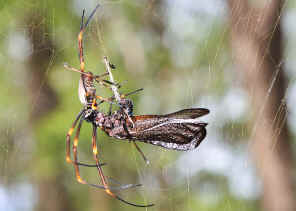
- This confirmed that male Mountain Katydid can fly.
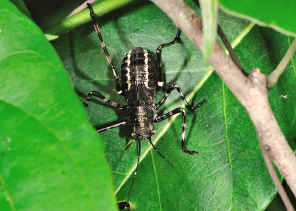
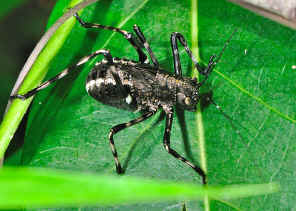
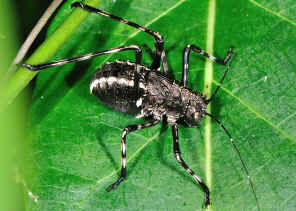
- We found this nymph when it was hiding amount short grasses on ground.
Found a male on Spider Web on Jan 2011 on Daisy Hills
Male nymph, Ford Road Conservation Area, Feb 2011
Female, Venman Park, Jun 2011
- Early winter in Brisbane we did not expect to see many insects. Walking fast on a footpath in Venman Park, suddenly a bright blue and red pattern flashing a meter in front of us. We stopped immediately otherwise we would step on it. Then we knew it was a female Mountain Katydid. The Mountain Katydid was mimicking the kangaroos droppings so we did not notice it. It displayed the "sudden bright" so that we did not step on it.
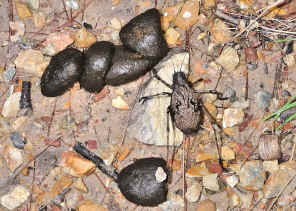
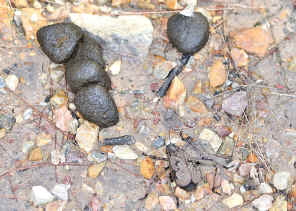
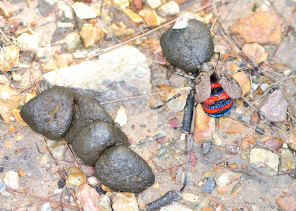
- Female Mountain Katydid are sometimes found sun-basking on ground. Their habitat is often where kangaroos are common. The resemblance of the females to kangaroo droppings is not an coincidence. The Mountain Katydid female mimics the kangaroo droppings, not to be seen, as the primary defence.
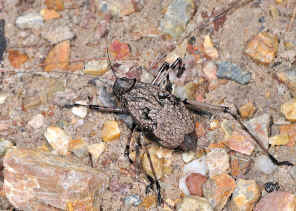
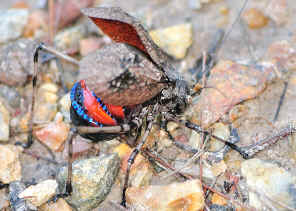
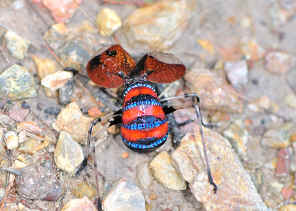
- It is a common understanding that an insect with bright body colours is distasteful. The host plants of Mountain Katydid include the Fireweed so this could be true. From what we had just experience made us thought that the "sudden bright" might serve another purpose. When they were resting among the kangaroos, they need this "sudden bright" action to tell the kangaroos not to step on them.
The Food Plants
- In the wild Mountain Katydid was observed feeding on Ragwort Senecio sp.. They fed on the whole plant included flower bud and half the pedicel. Serval introduced Ragwort pest, Senecio sp. were in the list. The native fireweed, Senecio lautus, should be on their menu too.
- Ragwort, Native Fireweed
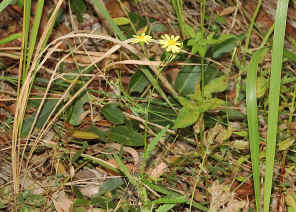
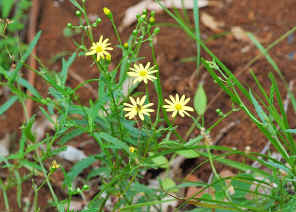
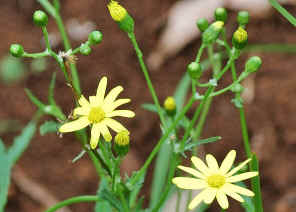
- Senecio lautus, family Asteraceae
- The Ragwort photos were taken at Beacon, Mt Tamborine, where and when I found the female and nymph. There were not too many found there.
- Ragwort Senecio sp. Itís poisonous and it stinks. Those plants that the Mountain Katydid eats would be unpalatable or even toxic to other animals. The Mountain Katydid stores them inside the body make themselves unpalatable to the predator.
- In captivity, they accept sweet-corn, lettuce and other salad-greens, Ragwort is always preferred.
Egg laying Habits
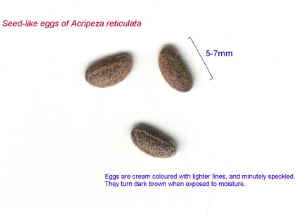
- Photo thanks to Ian Menkins
- Ian Menkins discovered that the Mountain Katydid females lay eggs in topsoil. Before Ian's discovery most believed that Mountain Katydids attached their eggs on stems or leaves high on the plants. Most katydids in Phaneropterinae lay the eggs in this way and Mountain Katydids attach their eggs to the sides and top of the cage. Ian found that Mountain Katydids did that just because the katydids were under captivity without soil.
- Also, Edith Coleman in her 1938 paper commented that she never found any eggs on the branches of trees or shrubs in the wild, although she expected they should be there.
Ian Menkins in his 2008 essay said: "I have only recently discovered that they often lay their eggs in the topsoil. They dig a small hole, lay the eggs, then carefully bury them and smooth the surface off meticulously with their tiny feet. Each female is capable of laying dozens of eggs in her lifetime. The eggs can take many months, possibly even years to hatch, waiting until conditions are just right. Only a small number of the ant-like young (called nymphs) will ever make it to adulthood." - "Each egg was covered with grains of soil that had adhered to the sticky gel, so they looked like small rough clods or pebbles. An ideal camouflage!"
- "As time went by, I witnessed the katydids and their egg-laying habits many times on a daily basis. They showed no preferences with regard to colour of clay media, and would choose garden soil, garden/sand/lime mix, or clay without bias. However, I noticed that they visited the saucer containing the 4-10 mm diameter clay chunks a lot less frequently than the other saucers."
- Baby Mountain Katydid about 3 mm long and ant likes.
Primary, Secondary and Tertiary Defence
- Because the Mountain Katydids are slow moving insects, they cannot avoid their predator by running away. The strategy that the Mountain Katydids apply to avoid predator is an typical example of slow moving insects. They apply the three steps; not to be seen, bluffing and show that they are not wanted.
-

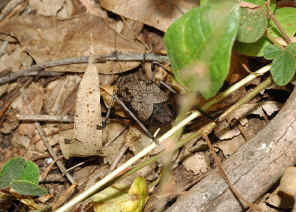
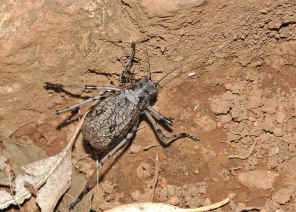
- Mountain Katydid males were usually low down on the stems where leaves were dead, harmonized perfectly with their colour. Together with their thin body, they are practically invisible. Female are sometimes found in group sun-basking on ground. Their habitat is often where kangaroos are common. The resemblance of the females to kangaroo droppings is not an coincidence. The Mountain Katydid female mimics the kangaroo droppings, not to be seen, as the primary defence.
-



- At a touch, up open the wing-covers showing colours in a "touch me now if you dare" challenge. This is the secondary defence - bluffing.
- The bright colour and distaste is a tertiary backup if the camouflage fails.
- Please check the Insects as Prey page for more discussion on this issue.
- Reference:
- 1. Insects of Australia, CSIRO, Division of Entomology, Melbourne University Press, 2nd Edition 1991, pp 384.
- 2. Acripeza reticulata - Australian Insect Common Names, CSIRO, 16 June 2005.
- 3. Australian Insects, An Introductory Handbook - Keith C. McKeown, 1945, p56.
- 4. Insects of Australia and New Zealand - R. J. Tillyard, Angus & Robertson, Ltd, Sydney, 1926, p95.
- 5. Grasshopper Country - the Abundant Orthopteroid Insects of Australia, D Rentz, UNSW Press, 1996, p111.
- 6. Notes on Australian Mountain Grasshoppers - Edith Coleman, Victorian Naturalist, vol. 55, 66, Field Naturalists Club of Victoria, 1938, 1939, 1944.
- 7. Mountain Katydid (Acripeza reticulata) - Menk from Darling Downs, Dec 31, 2007, Dave's Garden.
- 8. Coincidence or design ? - by Nuytsia@Tas, photostream, flickr, Uploaded on March 28, 2008.
- 9. Isolation of s-Butyl β-D-Glucopyranoside from Acripeza reticulata - John Cable and Harold Nocke, Aust. J. Chem., 1975,28, 2737-9.
- 10. A Guide to the Katydids of Australia - David Rentz, CSIRO PUBLISHING, 2010, p172.
- 1. Insects of Australia, CSIRO, Division of Entomology, Melbourne University Press, 2nd Edition 1991, pp 384.
